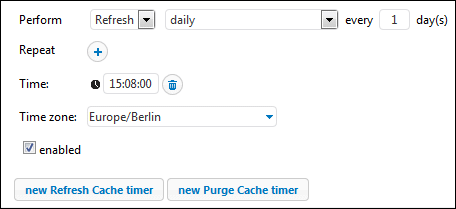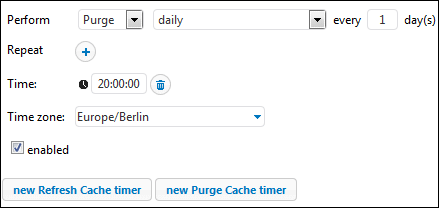Cache Result
Caching is a useful feature that reduces the server load and the response time of jobs. Caching the result of a job means that FlowForce Server prepares and stores the job result in some internal repository (i.e., the cache). If the job has parameters, the system creates a cache entry for every parameter combination.
When a job with the cached result is called from another job (referred to as a consumer), FlowForce Server returns the cached result to the consumer (instead of executing the job again). This reduces the response time of the job.
When you work with cached job results, note the following:
•It is mandatory to declare the return type of a job whose result is cached.
•A cached job and a consumer job must use the same credentials. If the credentials differ, the job executes as if no cache were defined.
•When you change the configuration of a cached job, the existing cache data is invalidated.
For an example, see Caching Job Results.
Caching settings
The screenshot below shows the Cashing Result section of the Configuration page.

The available settings are described below.
Setting | Description |
|---|---|
Cache the result | Select this check box if you want the job results to be cached. By doing so, you are instructing any consumers of the current job to read the cached result rather than execute the job. If the current job is executed directly (not through a consumer), FlowForce Server refreshes the cache. The job is executed directly when, for example, a defined trigger has fired or the job's Web service has been invoked. If the job parameters are not found in the cache, a new cached entry is created based on the supplied parameter combination.
|
Initiated by consumer | When this option is enabled, any consumer job that is calling the current job will compute and populate the cache if it does not exist. Otherwise, only triggers and Web service calls will populate the cache.
|
Maximum number of cache entries
| This option restricts the number of cached job results per job. When the job has parameters, you might want to set this option to the number of all possible parameter combinations.
|
Auto-create a new cache consumer job | A cache consumer job is a Web service at the HTTP address you specify. The consumer Web service acts as a convenient way to retrieve and manage the cache of the job whose result is being cached. When invoked, the consumer job attempts to use the cached result of the main job in the first place. If there is no cached result and the Initiated by consumer option is disabled, the consumer retrieves the actual result returned by the main job. If there is no cached result and the Initiated by consumer option is enabled, the consumer retrieves the actual result returned by the main job and populates the cache.
|
Refresh cache timer | The Refresh Cache timer (see below) controls how often the system should refresh the cache of the current job. All currently cached parameter combinations are refreshed.  |
Purge cache timer | The Purge Cache timer (see below) controls how often the system should clear the cache of the current job.  |
Save and refresh the cache | Click this button to refresh the cache manually. The button is located at the bottom of the job configuration page.
|
Refresh Cache and Purge Cache timers, click the ![]() button. The
button. The ![]() button (Duplicate) enables you to create a copy of the current trigger with the same settings.
button (Duplicate) enables you to create a copy of the current trigger with the same settings.